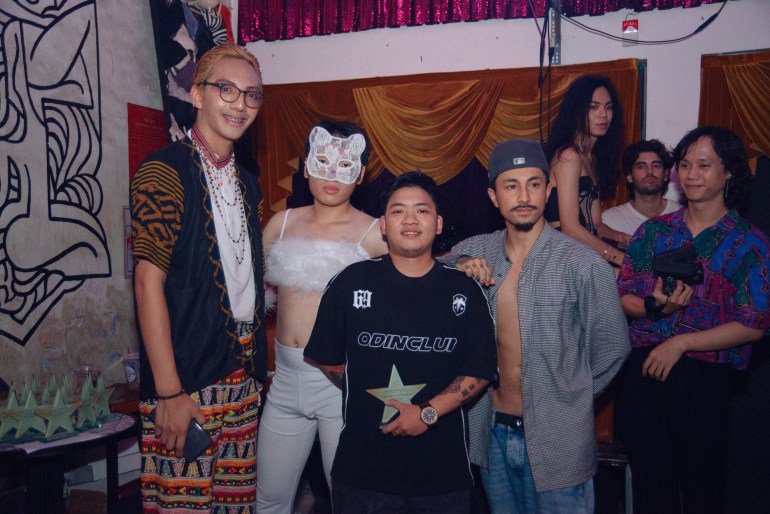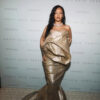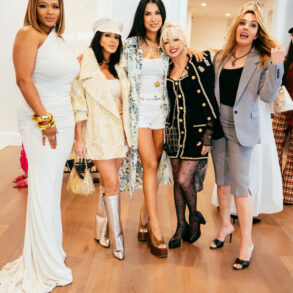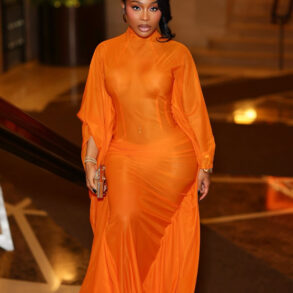Ho Chi Minh City, Vietnam – In a small, stuffy nightclub with walls scrawled with graffiti and flaking plaster, a queer function took place unlike anything seen before in the city that residents still call by its former name, Saigon.
Defining exactly what the event was presented a challenge for the uninitiated. It was a flamboyant party night for the LGBTQ community; a catwalk for would-be models with fiery dance-off battles, as well as an emotional celebration of kinship between Vietnam’s queer people – all rolled into a single evening and one event.
Participants had donned latex outfits with sequins and glitter that dazzled the audience as live rapping and a soundtrack of bombastic dance rhythms and rap set hearts pounding and kept adrenaline high.
Emcees and live DJs crafted and curated the night’s events in the heart of District 1 in Vietnam’s commercial capital, Ho Chi Minh City.
Welcome to the emerging world of “ballroom”, a queer subculture that has caught on in Vietnam and is providing a haven for gay and trans youth – as well as much fun – in Vietnam’s second city.
![A trans man (second from right) poses with the judges after winning Transmen Realness - a competitive category where trans men give the best impression of straight, cisgender men at Nguyen Hue Kiki Ball in Ho Chi Minh City [Courtesy of Ngo Tien Dat]](https://hoodoverhollywood.news/wp-content/uploads/2023/08/11-1-1-1692344189.jpg)
Not to be confused with ballroom dancing, which evolved from the heterosexual courtship tradition of European aristocrats, ballroom culture emerged in the 1960s among marginalised Black and Latino queer people in the United States.
Gathering at a “ball” function, queer people “walk” to show off their talents in dancing, lip-syncing, performing and catwalk modelling as a way to both compete on the night and, more broadly, transcend the everyday realities of gender identities, occupational roles and social status assigned in society.
Once an underground niche in the US, ballroom culture has found its way to Europe and Asia in the past two decades through voguing – a signature dance form of the ballroom scene and which blends the elegant poses of Vogue magazine models with the dramatic storytelling flair from African American dance culture.
“I first saw voguing after randomly scrolling on YouTube,” said *Riki Sun, one of the pioneering voguers in Saigon.
Recalling being captivated after seeing vogue performance videos by Daesja Mizrahi and Sinia Alaia – and other iconic trans women of ballroom culture – back in 2015, Riki Sun told Al Jazeera that once he heard the music and saw the movies, he knew voguing was “mine”.
![Aurora Sun Labeija, a trailblazer of Southeast Asia’s ballroom community, was one of the judges at Nguyen Hue Kiki Ball in Ho Chi Minh City [Le Xuan Tung/Al Jazeera]](https://hoodoverhollywood.news/wp-content/uploads/2023/08/6-1-1-1692344482.jpg)
Voguing has attained relative mainstream popularity over the past three decades, particularly since Madonna’s 1990 hit song Vogue and later featuring in the 2018 US TV show Pose, and more recently Beyonce’s Renaissance World Tour.
Viral videos of voguing battles have also been helped by the digital power of YouTube and TikTok algorithms, giving people around the world access to the dance form.
Just like the New York originators that built up the foundations of voguing on the streets of Harlem, Riki Sun told how he started practising the dance moves amid the bustle of Nguyen Hue Walking Street in Saigon’s central District 1.
Soon, other Saigon gay and trans folk joined in, finding the unapologetically feminine expression of voguing to be just what they needed in the machismo culture pervading the city’s street dance scene at the time, Riki Sun said.
Donning eyeliner, black lipstick and high heels, Riki Sun and four others formed the Five Fairies and started hijacking street dance battles, challenging Saigon’s macho break dancers and hip-hop heads, even winning some prizes at times.
But, the fairies soon realised that the street dance scene was not the right fit for voguing.
“In battles with hip-hop dancers, they see vogue and say it’s the same move repeated over and over,” said Naomi Sun*, a trans woman and one of the original Five Fairies voguing dance troupe.
“They don’t know what we are doing. Such battles bored us,” Naomi Sun recalled of the early years of voguing in Saigon.
“We wanted our own spaces, our own playground – why not?”

Riki and Naomi Sun, as well as other voguers, dreamed of bringing voguing to its rightful home at ballroom functions.
In June, that dream came to life in a District 1 club where the first ballroom function in Saigon was held.
It was titled the Nguyen Hue Kiki Ball in tribute to the street-level dance birthplace of the city’s vogue community.
At the ball, Naomi Sun, now a rising star of Saigon nightlife, was spinning vogue beats behind the DJ deck, while Riki Sun, now an authority figure in the scene, was perched on the judging panel while simultaneously showing the crowd how to vogue correctly.
Voguing was not the only performance featured at the ball.
Fashion-forward queer folks competed to emulate supermodels in the “runway” categories, those who came in everyday attire played up a cisgender, heterosexual mien to win praise in the “realness” categories.
There were also categories for the best faces, nail art, and even twerking performances – almost anyone could come to the ball and show off something they were good at.
“Ballroom is more than dancing,” Minerva Sun Mizrahi*, the chief organiser of the ball, told Al Jazeera.
“Here, people can vogue, do runway walk, or simply look and act straight-passing – all are considered talents,” Minerva said.
“It is a space to empower queer people.”
![JACK!, a drag performer and ballroom commentator, at the Nguyen Hue Kiki Ball [Le Xuan Tung/Al Jazeera]](https://hoodoverhollywood.news/wp-content/uploads/2023/08/5-1-1-1692345020.jpg)
Ballroom families and activism
At the heart of ballroom culture is what is called the “house system” – with designated father and mother figures as overseeing mentors, providing their adopted children with ballroom competitive tips, as well as support – mental and sometimes financial – to help navigate life as queer people.
Beginning among disenfranchised queer youth who were abandoned by their families because of their non-conforming identities in the US of the 1960s, they formed chosen families and shared the resources needed to survive. That tradition continues today through “houses”, which are structures of kinship that provide a home for members, who are also known as children.
“Ballroom is like a cultured family. The most important thing is to love and care for each other as a real family,” Riki Sun said.
![Riki Sun, left, and Mui Neverland, right, two performers of Southeast Asia’s ballroom community, at Nguyen Hue Kiki Ball in Ho Chi Minh City [Courtesy of Le Xuan Tung]](https://hoodoverhollywood.news/wp-content/uploads/2023/08/3-1-1692345210.jpg)
On top of fostering local voguing talents, Riki Sun has also assumed the role of caregiver for queer brothers and sisters over the years.
Riki Sun supported Naomi Sun and other trans friends as they jumped through hoops to get access to gender-affirming surgeries in Vietnam.
For Riki Sun, protecting trans people, especially trans women, should be a priority for the ballroom crowd.
“Ballroom is here to protect trans women. No matter what the people out there think, ballroom should allow them to be themselves and get their rights guaranteed,” he said.
For Naomi Sun, support from her ballroom “brothers and sisters” is much needed, as Vietnam still has a long way to go towards transgender rights.
Positive news appears to be on the way, though.
![Ni Xinh, a DJ and ballroom commentator, emcees at the Nguyen Hue Kiki Ball [Courtesy of Ngo Tien Dat]](https://hoodoverhollywood.news/wp-content/uploads/2023/08/4-1-1-1692345403.jpg)
A draft of the long-awaited gender affirmation law, which will allow sex changes in Vietnam, has reached the last round of consideration and could be codified by Vietnam’s National Assembly in 2024.
However, discussion on whether or not medical interventions should be required for those seeking a legal change of sex remains a heated debate in the country’s legislative body.
Contemplating what the future law might involve, Naomi Sun said she was not enamoured at the thought of having to physically prove her trans identity to a government council to get official paperwork.
“It’s like controlling, if you want to change,” she said.
Social acceptance of trans people also lags behind in Vietnam, even in Saigon where gay men and women enjoy relative acceptance in society.
Trans individuals, however, are still considered “other” and discredited for their gender identity, Naomi Sun said.
As one of the first trans DJs in Saigon, she had to fight hard to overcome stigmas by promoters and get jobs in the local nightlife industry.
That is why ballroom events are so unique, as they are one of the few safe spaces in Saigon where trans women can just “let loose and have fun”, Naomi Sun said.
“You don’t have to do anything to your body or take hormones; just dress up as a fem queen [which is the ballroom slang for a trans woman], go there, and live your dream as a fem queen,” she said.
“It’s fine! That’s how ballroom is.”
*Riki Sun, Naomi Sun and Minerva Sun Mizrahi are stage names used by the performers who preferred that their real names not be disclosed for privacy reasons.
This post was originally published on this site be sure to check out more of their content.








